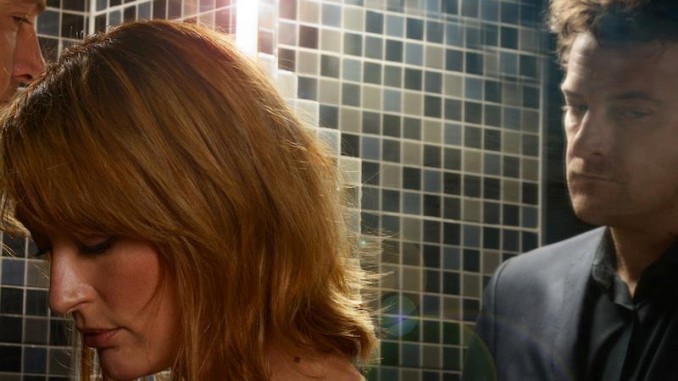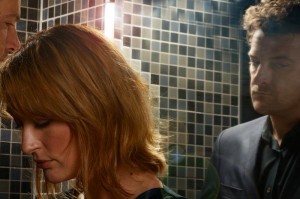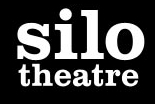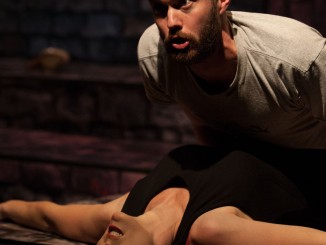
Same, but Different [by James Wenley]

The harder you try to categorise Speaking in Tongues, the further the play slips away. Case in point: the content of the opening scene is the stuff of conventional dramas – in separate hotel rooms, two couplings of strangers contemplate engaging in infidelity. The tension: who will go through with it, who will back out? But the form is unconventional and theatrically exciting: the dialogue between the separate couples is paralleled, overlapped, shared. So often two separate characters speak in one voice. We notice the mechanics and patterns that build towards a dangerous liaison.
There’s something else about this scene too. Leon (Stephen Lovatt) and Jane (Luanne Gordon) are in one hotel room. Pete (Oliver Driver) and Sonja (Alison Bruce) are in a second. These couples on the verge of a betrayal are intimately connected. Pete is married to Jane. Sonja to Leon. What are the chances? Very high in the small world of Andrew Bovell’s play.
Tongues could easily remain operating in the middle-aged detritus of these couplings, tracking confession, revelation, destruction, and (potentially) restoration. The beats of act one do hit these moments (including a memorable coincidental meeting between Leon and Pete), but two separate stories expand exponentially the concerns of the play. Sonja relays how she witnessed a neighbour throw a woman’s shoe into a vacant lot. Leon recounts crashing into a jogger, wearing “beautiful” brown brogues, and learning of his story of personal heartbreak. A lot of time is spent in the detail of these darkly imaginative stories which shall not be spoiled, but they introduce concerns which are picked up when we meet a new cast of characters in act two played by Lovatt, Gordon, Driver and Bruce.
Silo is in familiar territory with Tongues, and it’s surprising the company hasn’t previously staged the 1996 play. There’s that odd sense of déjà vu about it. The stage terrain is that trendy-minimalist sort of Silo look with versatile backless couches, vertical neon light highlights via Sean Lynch, and encroaching darkness on the edges. Silo consider their 2010 production of Bovell’s When the Rain Stops Falling (also starring Lovatt) as one of their triumphs, and here we can see director Shane Bosher continuing his explorations of bodies in space from that production through this earlier play. Tongues replaces Victor Rodger’s earlier advertised Protection and no doubt needing to program a new show on short notice, a more uncannily perfect fit could not be found in Tongues, especially as Bosher will soon be moving on as Artistic Director.
I’ve long admired Bovell’s playscript since encountering it in undergraduate study (Bovell says the play “doesn’t follow the normal rules of playwrighting”), and the case can be made for the play as one of Australia’s modern classics. A nod to universalism, Silo’s performers speak in their local accents, and it feels of this place (a localised trailer with its foreboding nature shots situates it neatly within a recognizable kiwi gothic aesthetic).
The demanding opening scene of “double infidelity” with simultaneous dialogue and exacting timing represents a puzzle and irresistible challenge for the director. The device takes some amount of work for the performers, but also for the audience as we are demanded to tune in and make sense of the babble of voices. There is a lot of mirroring – both men “haven’t done this sort of thing before” and experience pains in their chest. Both women say they don’t want to leave. Sometimes it is the original married couples, such as Pete and Jane who speak in unison (“We hardly know each other”). The scenes play out the same, but different. Unity with variation. Instead of two separate rooms, Bosher unlocks the scene by overlaying the action so the performers all oscillate within the same space (as in Rain), passing dangerously close to their wedded partners – who are in a different place, but unified in space. Lines take on added irony in that they are addressed to one person, but the close proximity means we can read different meanings as if they are addressed to the other.
There’s a fascinating tension introduced in the writing and borne out in the direction between the universal and individual experience. All individuals – Pete, Jane, Leon, Sonja – seem to have felt the same collective urge to pick someone up, to “feel something”, and all made their way to the right bars. Bosher visually creates and breaks patterns and allegiances between characters on the stage, and there is a keen eye for body language through which Bosher and the performers establish some key differences between the characters from the outset. And while they might say the same thing, at the same time – body language adds a discordant note, a competing language that also calls for close scrutiny.
In act two the new cast of characters – Valerie, Sarah, Nick, and Neil (who are anticipated in Leon and Sonja’s stories) jolt forward into the spotlights at the front of the stage, choreographically compelled by a higher directorial power to reveal a dream they keep experiencing. The dreams are similar, but with subtle variation. Two take the subject point of the voyeur; two feel as if they are being watched. They appear uncannily in each other’s shared dream. Again, individual agency is under question.
Clear Perspex lines the back of the stage, capturing the performer’s reflections, and though a little murkier, the audience’s own. It’s an obvious choice from designer John Verryt. The couples are already doppelgangers of themselves at the beginning of the play, the double infidelity mirrored twice-fold with this design feature. By catching us too, it accentuates the commonality of this infidelity experience. It might not be something we would wish to readily acknowledge, but social statistics illustrate how common a experience this is. So far, so hum drum. But the Perspex reflections justify themselves in the third act where Driver appears as third character John, Lovatt returns as Leon, and they interact behind the Perspex (which has been shifted further towards the audience). In front, a scene between therapist Valerie (John’s wife) and patient Sarah is juxtaposed. With this image, we see multiple viewpoints: Leon looking at John, Valerie looking at Sarah, and through the mirror angles we see Valerie looking at John, Sarah at Leon. I’m reminded also of the actor’s previous roles, and the previous relationships between the first couples, and also the characters that Leon and Jane talk about in their stories. I see the myriad of connections in this play crystalize.
It’s refreshing to see Driver retreat inwards; his characters’ sharing issues of self-esteem. His height becomes a vulnerability rather than his usual weapon. Lovatt and Bruce are more conventionally cast to type, Lovatt the brooding hyper-males, Bruce with the strong façade but hurting interior, her deeper vocals catching our ear. Her increasingly anxious Valerie, trying to get home on a dark night, haunts the second half. Gordon, long absent from the Auckland stage, becomes the big revelation and pleasure of the production, contrasting the latent curiosity and hope of Jane with the rudderless, and dangerous Sarah.
Paul Mclaney’s noir-like composition, commissioned for this production, sets an unsettling aural undercurrent. Charlotte Rust’s costume design rightly doesn’t draw attention to itself, the natural skin of the various characters.
Some of Bosher’s extra flourishes are questionable; the drama works best when the audience lean in to figure it all out, rather than when it’s forced out towards us. A message of “HELP” that Valerie writes on the Perspex, and subsequently remains boldly visible for the remainder of the running time, seems a glib oversimplification of her state, and the play’s themes. Bovell’s writing can be accused of an extra unnecessary flourish at the conclusion – one connection too many spelt out – and a little cheap after the penultimate climax. Bovell’s 2001 film adaptation, Lantana, drops this particular plot point. For those who are engaged by Tongues, Lantana makes for its own uncanny doubling of the Tongues story. Same, but different (and a brilliant film).
Tongues is a relationship drama, a crime thriller, and a psychoanalytical puzzle, but also seems to be none of these. It seems to be a play about connections between people. But then that slips away. The connections are bad; we see the hurtful things people to do one another. “People are capable of inflicting the most unbelievable pain onto others” says Leon. This is not a hopeful play.
But then maybe the play is not about connections, or bad connections, at all. It is about a lack of connection, a failure to communicate. People speak, but they are not understood. They may as well be speaking in tongues. They see, but they misunderstand. Experiences remain subjective, individual, and misinterpreted by others.
“Speaking in tongues” has another meaning; of giving yourself over to something bigger than yourself, the body a conduit of another force – as if the things we say are prescribed from a playwright on high. The feelings, the urges, are predestined and shared. Where does the individual experience end, and the shared begin? The couples at the play’s opening are automatons, mechanically enacting a mirrored scenario. A delusion of originality?
And then there is us – watching from our seats – and our reflections just visible, implicating us in our gaze. What do you see? What do you feel? What do you hear? What about the person sitting next to you? Same, but different. Different, but same.
Like the characters within the play, I have grappled for meaning. I told you this play was slippery. And though it fits snuggly into Silo and Bosher’s oeuvre, you probably haven’t seen any other play quite like it. Listen watchfully.
Speaking in Tongues by Andrew Bovell is presented by Silo and plays at The Herald Theatre until 14 September. Details see THE EDGE.
SEE ALSO: Theatreview.org.nz review by Adey Ramsel




Leave a Reply